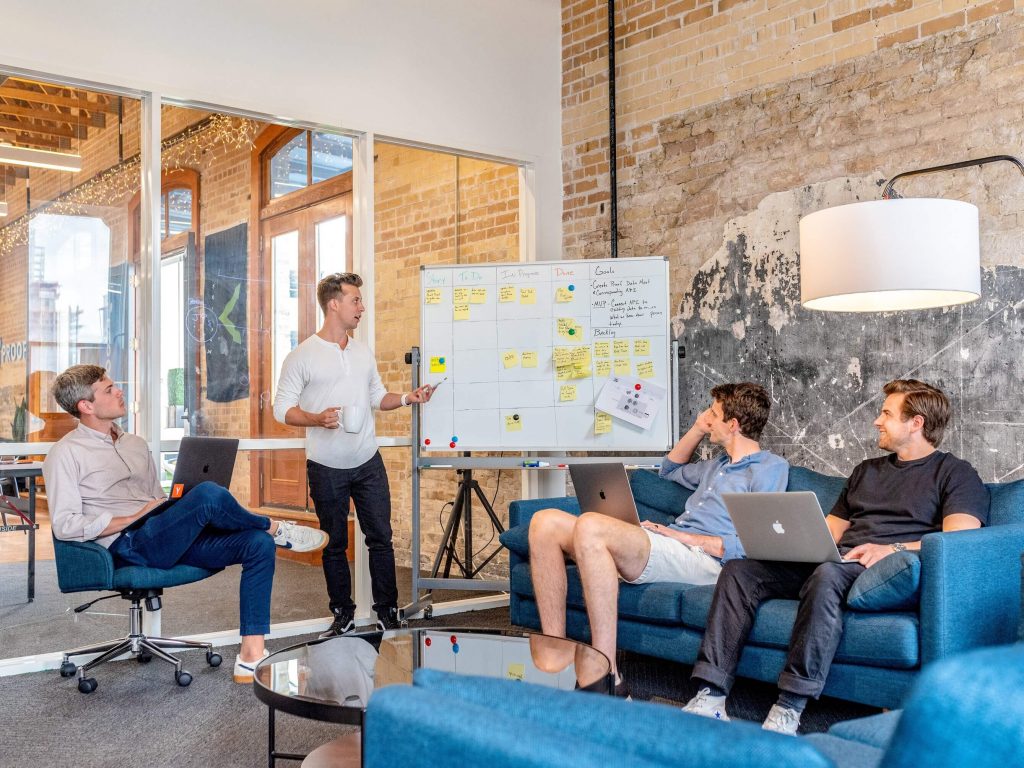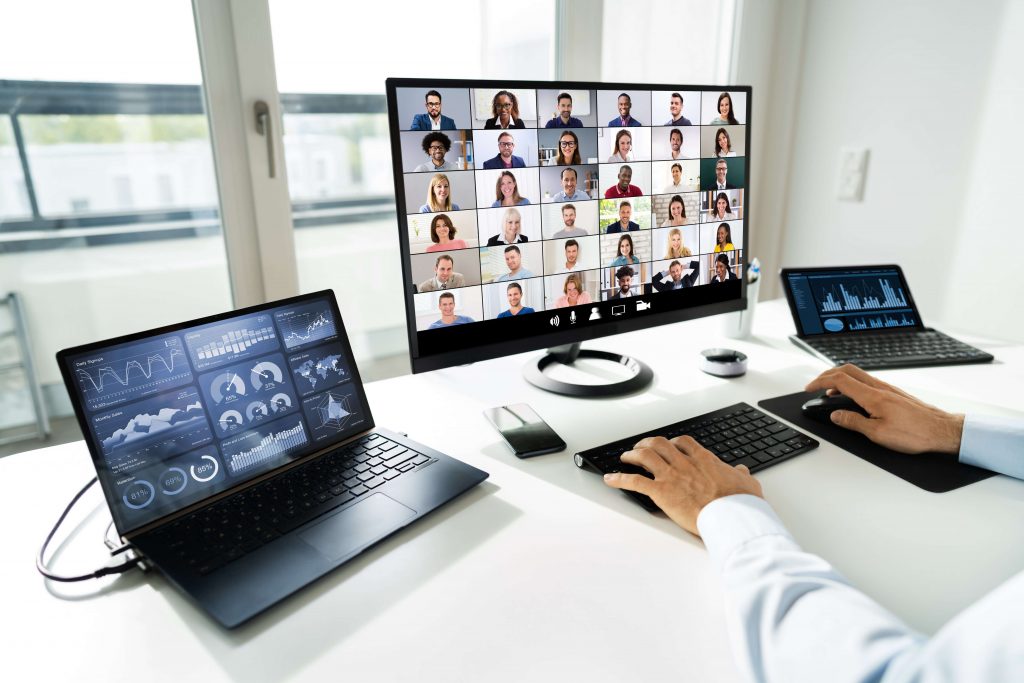This is the third and final post in our three-part Hybrid Workplace Series. Through this series, we take a look at the meaning of the ‘hybrid workplace’, tips for building an effective hybrid workplace that supports your employees, and how the changing office landscape will affect and shape workplace collaboration moving forward.
In the first two posts of this series, we focused on the meaning of the hybrid workplace and how organizations can build hybrid workplaces to best support their workforce. For the last post of this series, we’re going to zoom out. We’ve provided some insights into how individual organizations can prepare their offices for success, but in this post, we’ll take a look at the fabric of the workplace landscape as a whole. How have the pandemic, new work norms, and the acceleration of the hybrid workforce impacted the restructuring of office zip codes, real estate models, and physical footprint? As our workplace model enters a state of flux, what exactly is the purpose of the office? And how will the more dispersed workforce impact the office and future workplace collaboration?
Decentralization of the Office – Back to the ‘Burbs

As the pandemic has drawn on, a number of news articles have highlighted shifts in the way companies both large and small are thinking about their real estate footprint and – in some cases – the need for a physical office at all.
As many offices continue to sit vacant, many companies are reconsidering the sky-high rental costs of their high-rise buildings and expensive downtown headquarters. A number of Silicon Valley and other large companies have announced that many employees will not need to return to the office – ever – providing fully remote work options.
Even for those organizations that are keeping physical office space, there has been an increased migration away from big, expensive cities to smaller cities and suburbs, curbing the costs of expensive downtown headquarters by relocating from places like San Francisco and New York City to midsize cities like Boise, Denver, Nashville, Austin, and others. Just this morning an advertisement on the podcast I was listening to promoted the value and advantages of moving your business (or your new WFH life) to wonderful – Ohio. And Ohio isn’t alone in locations that are tapping into the benefits of remote and hybrid office models to attract workers to their state/city, as less expensive real estate markets tout their advantages for both lifestyle and business bottom dollar.
Hub and spoke models have more companies considering smaller satellite offices in the suburbs, relocating in concert with the movement of their employees, who also see the value of escaping big city costs for bigger homes and lower costs further outside the city.
Virtual Office Space
Finally, the pandemic has ushered in an acceleration of digital and virtual cloud-based offices. This description ranges anywhere from simply connecting your office and workers with a series of cloud-based tools, to SimCity™-like environments that gamify the workplace in an effort to bring the in-person office experience to the remote world. Virtual meeting start-ups – complete with spatial dynamics that allow users to move about and interact within the virtual office or conference – aim to provide a more immersive experience than Zoom and Slack.
However, noting some of the advantages of virtual meeting platforms, a New York Times article points out, “Capabilities like these point to a future of meetings that is increasingly data-driven, efficient, unbiased, inclusive and accessible – but also possibly soulless.”
As an increasing number of tools seek to replicate or even surpass the office experience – from impromptu water cooler banter to meetings and even virtual desk space – organizations and individual workers alike confront one of the most important questions for the future of the physical workplace –
What is the Purpose of the Office?

Since we’ve determined that we can do ‘work’ from anywhere, as a recent New Yorker article article asked, ‘what’s an office for?’ Many workers have found their stride accomplishing some tasks from home even more efficiently than they might have in the office. As the article notes, “it turns out that work, which is what the office was supposed to be for, is possible to do somewhere else.”
As the hybrid workplace notion aligns the concept of the ‘workplace’ more with purpose than place, we must ask:
What is the purpose of the physical workplace?
While we have certainly found ways to accomplish much of our work at home – there is more to ‘work’ and a ‘workplace’ than physical tasks, deliverables, and deadlines. There is a reason that many organizations invest heavily in office culture and community – it impacts unity, cohesion, and a sense of belonging and ownership with one’s team, organization, and work. In short, it impacts your work.
With only a quick brainstorm, much of what comes to mind about a workplace actually has very little to do with the final deliverables at all – but makes all the difference in ushering those products, projects, and assets from conception to completion – and keeping workers happy while doing it. Just some of the important functions of the workplace:
Collaboration & Learning
- in-person collaboration & brainstorming
- spontaneous interaction & ideation
- mentorship & learning from colleagues
- new hire integration into company culture
- professional networking & relationship building
Community & Purpose-Driven Atmosphere
- fostering office culture, unity, and a sense of community
- office atmosphere/buzz/energy
Focused Work Space
- specialized equipment, tools, and spaces
- focused work away from home/family/children
- work-life balance through separation of places/spaces (the office as the place where we do work; the home as the place where we… do not do work)
The concept of team building wasn’t just created to produce funny episodes of The Office (but thank you anyway, Steve Carrell) – it has a real purpose. Regular day-to-day, face-to-face interactions with our colleagues are a meaningful part of the work experience – even if we aren’t always talking about work.
In a recent AVI Systems webinar, CTO Brad Sousa talked about the idea of tasks versus sense of community, noting that work from home mostly feels like tasks rather than the sense of community that is developed through working on big projects together in the office. Mersive’s exec team has also thought deeply about this topic. Many of the ideas and projects that were conceived, built, and nurtured pre-pandemic and came with us into the early months of work from home have now run their course. Do new projects and plans gather the same energy and momentum without the in-person collaboration and synergy of the office? Is the social capital that was built through our personal connections in the office being depleted? And – is there a way to harness the same momentum, energy, and social connection through a dispersed work model?
In a conversation with the New York Times, an investor from venture-capital firm Electric Capital noted the value of serendipitous interactions for creativity and innovation, arguing that “remote work currently trades serendipity for efficiency.” In other words, we may be getting a lot done from home… but we may be missing many of those critical interactions that spark great ideas and snowball into innovation.
And so – while some of the things listed above may be done online – and indeed this is what the virtual office start-ups and fully remote organizations of the world are working toward – there has been recognition across many organizations that there is value in combining the best of on-prem work with the efficiencies and convenience of our work from home lives. The future is hybrid.
The Best of Both Worlds: Creating the Hybrid Workplace

As we talked about in our first post of this series, the concept and practice of hybrid workplaces has been around for quite some time; however, in earlier remote and telework frameworks, there was really no great impetus to go out of the way to accommodate a remote worker when the majority of workers were in the office. If something was so important that someone needed to be in the office, they would be.
As we’ve moved through the pandemic and consider our post-pandemic workplace landscape, the office has been turned upside down – many knowledge workers are currently operating in an environment where remote workers are not only important, but likely in the majority. And, if workplace surveys are any indication of what’s the come, this is likely to continue to be the norm.
Both organizations and individual workers recognize – and even pine for – the benefits of in-person interaction, though also acknowledge the convenience and productivity that many have discovered working from home. The new paradigm for the workplace is shaping up to be far more centered around flexibility and personal choice.
Now that we have arrived at this hybrid workplace model – the core question is, how do we blend the best of the physical and digital workplace? How can we take the list of workplace functions above and port them to a workplace that isn’t solely in-office or solely remote, but a dynamic and continuously changing combination of the two?
How Collaboration is Changing
For many workplaces, the pandemic has followed a familiar pattern. Pre-pandemic most work and collaboration was done primarily in-office, in person, though there was a steadily growing trend toward remote work/work from home. Throughout the bulk of the pandemic timeframe, both work and collaboration were shifted to a primarily remote existence, each person occupying their own small square on a screen: the Brady Bunch grid of our pandemic workplace family. Now we see individuals slowly trickling back into the office.
How we interact and collaborate now, as a dynamic hybrid workforce – possibly with a new office real estate structure or even virtual meeting or office tools – will be different than we did as primarily on-prem or fully remote organizations. While the changes will be many, we offer three key changes across technology, social psyche, and space to keep in mind as you consider your hybrid workplace:
-
Technology: Explosion of cloud-based communication and collaboration tools.
The rapid proliferation of software and cloud-based technologies and tools will have a dramatic impact on how we meet and interact both in-person and in the digital environment. Key elements for organizations to keep in mind as they investigate collaboration solutions and tools for their workplaces are flexibility, parity, and portability. As the shape of the office continues to change, flexible collaboration solutions that can integrate with existing infrastructure, hardware, and platforms will provide organizations with the ability to more easily and cost-effectively scale tools across spaces as needs change. Technology solutions that create an equitable experience for all workers, regardless of location, will also be key in the more dynamic, hybrid environment. Finally, workers have grown used to being able to access everything they need from their laptops and other personal devices. Even as we move back to the office, this ease of use and ability to move throughout the office infrastructure – and seamlessly integrate with it – with everything we need for collaboration at our fingertips in any space will continue to be important and even expected.
-
Social: Changes in the psyche around collaboration.
Because we are a tech company and not social psychologists, I will not go very deep into the human condition here but to say, we recognize that there is very much a social component that is on par with or even exceeds the importance of technology – or at the very least, should be a significant consideration and influence as we develop collaboration technologies for the future. Over the past year, we quickly ported work to home. Porting it back will take more time – and will take a much different shape. The pandemic has impacted people in a broad range of ways, and, with changes to the social patterns developed over the last year, so too will there be changes in how we interact and collaborate as we emerge. While some are chomping at the bit to rejoin group functions, still others are very hesitant to participate in group settings or have simply found routine or increased focus and productivity in their work from home setting. The flexibility brought by the hybrid workplace should reassure those who are more comfortable working from home and will make it all the more important for organizations to provide technology and tools that bring the remote worker into the fold, putting them on equal footing with those in the office.
-
Space: Purpose-driven spaces and experiences.
While we’ve already discussed changes to the spatial landscape of the workplace, with movement to the suburbs, creation of satellite offices, an increasing crop of virtual office workspaces, and other solutions that have sprung from the pandemic, the other space to consider is the space within the office itself, and how it will impact collaboration. Now that we have discovered that we can do much of our work from home, the spaces and experiences provided in the office will need to serve very particular functions to draw workers into the office – a sort of consumerization of our offices. I already have a quiet desk at home, so what will draw me into the office? Maybe what I really need for an upcoming project planning meeting is a brainstorming room, with plenty of displays, whiteboard space, and room for participants to spread out. Those with distracting home environments, such as small children at home, may be drawn in by focus spaces or private offices that can be reserved on an ad-hoc basis. And still others will look for particular meeting, training, and group spaces with specific technology and amenities to support collaboration and interaction with colleagues, clients, vendors, and others. This idea of the office as a consumer product will drive innovation around the spaces and the infrastructure that serve them.
Supporting the Hybrid Workforce
Despite the fact that the office is not dead, there will be major changes in the way we collaborate – how we meet, where we meet, the design and interaction within our meeting spaces, and even how we find our colleagues to connect and collaborate. No matter what model organizations choose for their physical office space – from a centralized downtown headquarters to satellite offices in the suburbs, or even integrating virtual office space apps into the mix – creating a workplace that is both flexible for employees and productive for business will require tools that support meaningful collaboration between both in-office and remote workers.
The benefits of both in-person collaboration and remote work are numerous. Now we must strike the right balance between our physical and digital worlds – between serendipity, productivity, and efficiency. This balance will look different for each organization and each individual worker – and will vary even daily by preference, role, and task. It’s an exciting time to be involved with workplace space, technology, and purpose – and individual worker preference is driving the way. So… will you meet me at the virtual water cooler? Or the real one?
